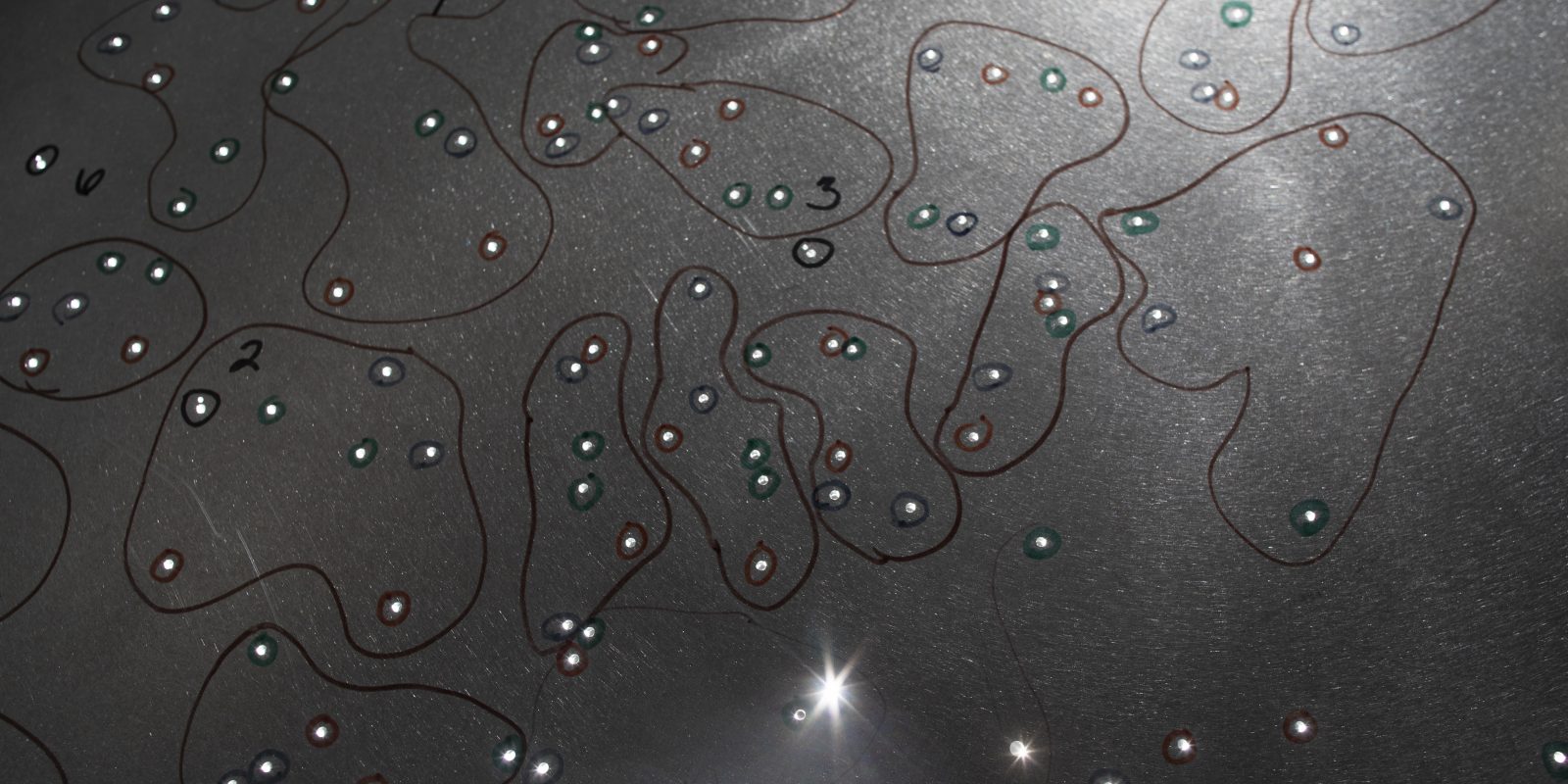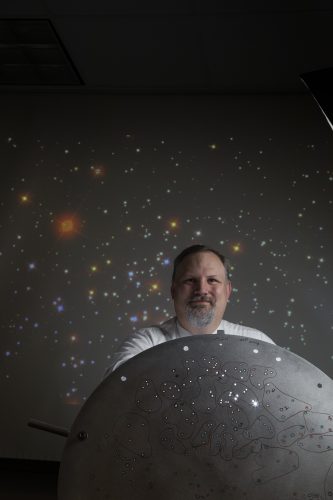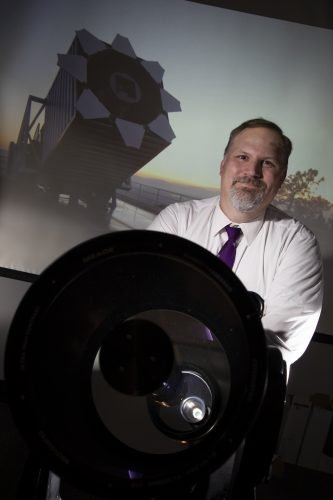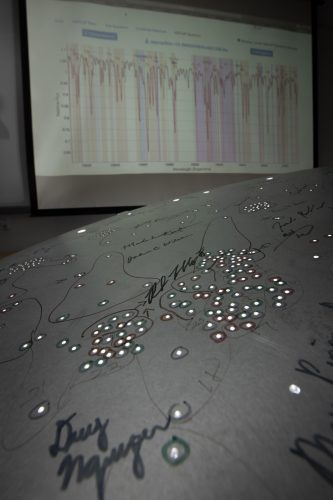
Peter Frinchaboy uses aluminum plates drilled with hundreds of tiny holes that map to a specific region of the sky. Photo by Rodger Mallison
Mapping Faraway Galaxies in Sloan Space Initiative
Under Peter Frinchaboy, TCU plots stars in the international collaboration.
Washington, D.C., 1934: American optician George Willis Ritchey and French astronomer Henri Chrétien arrive at the U.S. Naval Observatory for the unveiling of their latest invention.
Designed in a joint effort, the 40-inch Ritchey-Chrétien telescope was the first hyperbolic double-mirror telescope to turn its gaze to the stars, thus revolutionizing astronomy.
Their mirror system is still used today by observatories around the world and by NASA’s Hubble Space Telescope.
Even more important, the international partnership responsible for the telescope’s creation has become the model for one of astronomy’s most influential organizations. With partners spanning the globe, the Sloan Digital Sky Survey is poised to become astronomy’s next pioneering step.
The organization’s goals change from one sky survey to the next. But its two driving objectives remain the same: to create a comprehensive, high-definition map of the known universe and to foster an astronomical community with international members.

Peter Frinchaboy, associate professor of physics and astronomy, uses specially prepared aluminum discs to make spectrum measurements of stars and galaxies. Photo by Rodger Mallison
Thanks to Peter Frinchaboy, associate professor of physics and astronomy, TCU is an active partner in the global initiative. His role, including managing the observational schedule for telescopes in the fourth survey, ensures the university’s spot in the organization for years to come.
And his discoveries about star migration anomalies might unlock new clues about how the Milky Way galaxy has evolved.
Bright Minds
The Sloan survey is a collaboration among dozens of institutions and includes astronomers from Yale University, the University of Cambridge, Nanjing University, Universidad de Chile and the Korean Institute for Advanced Study.
This international initiative has made massive strides in mapping the stars. These include the discovery of dwarf galaxies orbiting the Milky Way and the identification of hypervelocity stars, which after orbiting too close to the black hole at the center of the Milky Way are slingshot out of the galaxy.
The Sloan survey came about after the launch of the Hubble Space Telescope in summer 1990. James Edward Gunn, one of the primary designers of the camera on board the telescope, was furious with NASA for sending the satellite into space with a faulty mirror that severely crippled its capabilities. (NASA launched a spacewalk mission in 1993 to add a corrective lens.)
Calling the telescope an astronomical failure, Gunn returned to Princeton University, where over the next six years he designed one of astronomy’s most complex telescopic cameras and installed it in what became the Sloan survey’s first telescope.
After proving the telescope’s effectiveness, Gunn invited fellow astronomers to be part of his survey. Though management problems and a lack of funding made for a rocky start, Gunn and his peers scraped together what they could and kick-started the program on its first round of sky surveys.
Starting in 1998, the first two surveys collected detailed multicolored images of more than 25 percent of the observable universe, generating in-depth maps of more than 900,000 galaxies over eight years.
Collaborating astronomers collect the bulk of the data from three telescopes. Two of the telescopes, built by the survey team, operate at the Apache Point Observatory in Sunspot, New Mexico.
The first of these two is Gunn’s 2.5-meter-diameter Sloan Foundation telescope. It is equipped with a near-infrared imaging array capable of seeing through the denser fogs of space that color and monochrome cameras cannot penetrate.

Peter Frinchaboy and the Sloan Foundation use powerful telescopes, including one at Apache Point Observatory in New Mexico, to collect data. Photo by Rodger Mallison
The second is a 1-meter robotic telescope capable of operating without on-site personnel. This imaging device can record celestial bodies that are too close and too bright for the larger telescopes to observe.
The third telescope is the 2.5-meter Irénée du Pont Telescope at the Las Campanas Observatory in Atacama, Chile. Joining the sky survey in 2010, the du Pont telescope provides a crucial point of observation from the Southern Hemisphere and gives scientists access to parts of the sky that the other telescopes have difficulty covering.
In comparison to the Hubble Space Telescope photographing the universe from Earth’s exosphere or the record-breaking 10.4-meter-diameter lenses of the Gran Telescopio Canarias, the survey’s telescopes — with their comparatively banal size and locales — are unremarkable at first glance.
Although the Hubble telescope is powerful, it is able to cover only small swaths of space at a time. And while the Gran Telescopio Canarias, in the Canary Islands, is capable of higher-resolution imaging than most telescopes, it likewise suffers from a constrained field of view.
The Sloan collaborative, on the other hand, boasts a fleet of telescopes that can collect astronomical data over large portions of the sky from multiple locations. Each of its telescopes fills a specific role, accounting for any shortfalls of its peers.
Together, they can comprehensively map the stars — something no observatory can do on its own.
The same can be said for the survey partners. Each institution adds something different to the organization. As a result, participants have access to a global network of scientists, data and equipment that any one institution would be hard-pressed to match.
Fresh Focus
As the Sloan Digital Sky Survey grows, its greatest asset remains its people. Before each round of the survey, a collaboration council reaches out to institutions across the world in search of new contributors.
Each fresh survey provides newer members the opportunity to influence the projects and goals that the overall group will focus on. This ensures that each survey, starting with the first through the current fifth round, reflects the interests of the people working on it.
When he joined the TCU faculty in August 2009, Frinchaboy put a high priority on making the university a member of the Sloan survey.
To cover the joining fee, Frinchaboy performed technical work for the third sky survey, and TCU also kicked in funding. That provided access to the data for not only Frinchaboy but for all the students working with him.
“We actually became partners with the III, and we have continued being partners,” Frinchaboy said. “It has been a huge payoff in terms of our access.” Each round of the survey is denoted by Roman numerals, much like the Super Bowl.
Research astronomer Kat Barger came on board in 2014 for the fourth and fifth surveys, giving TCU two faculty “slots” of access.
“We actually have the ability to influence what the survey that is being done is, not just hoping the data that we want comes out from somebody else’s survey.”
Peter Frinchaboy
Also in 2014, Frinchaboy was joined by John Donor ’17 MS (PhD ’20), then a graduate student, for the fourth and fifth surveys. Their contributions have included collecting and organizing data from the telescopes and scheduling meetings and access to equipment. Donor is now a post-doctoral scholar, filling TCU’s postdoc slot.
Being a member of the sky survey team holds several advantages. Members immediately gain access to all data collected by the foundation a year and a half before the public is granted a peek. More significantly, member institutions can propose survey targets.
“We actually have the ability to influence what the survey that is being done is,” Frinchaboy said, “not just hoping the data that we want comes out from somebody else’s survey.”
Frinchaboy has proved a valuable member of the Sloan team. As part of the management committee during the fourth survey, Frinchaboy was integral in ensuring every team within the foundation had access to the necessary resources.
“Peter’s role [in the survey] is very significant,” said Michael Blanton, a professor of physics at New York University and the director of the fourth survey. “Peter was really the lead person who was taking the input from all these surveys and made sure that jigsaw puzzle all fit together.”
With over 70 institutions working in specialized teams on various projects, ensuring that every group can collaborate successfully is crucial.
In the Zones
The international nature of the cooperative has led to one obstacle that Frinchaboy and Donor must constantly navigate.
“The time zones are fun in terms of problems,” Donor said. “We have people all over Europe, and sometimes we have people calling in from Australia … so organizing that is always fun.”
Aside from the scheduling conundrum, both professor and postdoc scholar espouse the many benefits of the organization’s cultural melting pot.
“The atmosphere that’s fostered within the collaboration is really quite impressive,” Donor said. “I don’t think you see that kind of atmosphere in a lot of places in the professional world.”

Fellow scientists and some of Frinchaboy’s students who worked on the project signed the aluminum plug plate they worked on. In the background, a graph shows the chemical elements detected in various stars by means of spectrographs. Photo by Rodger Mallison
The open camaraderie is no accident. As a consequence of decades of hands-on learning, Sloan members understand how vital it is that every voice is heard.
“It requires more work to be attentive to what’s happening in Italy, China, etc.,” Blanton said. “It’s something we’ve learned to pay attention to over the years.”
The internal management committee, which includes Frinchaboy, addresses issues raised by survey members.
New hires are treated with the same respect as program veterans.
“In the committee on inclusiveness, when we run our meetings, we emphasize early career people getting to ask their questions first,” Frinchaboy said.
This borderless partnership is reminiscent of Ritchey and Chrétien, astronomers from different parts of the world who came together to open a new frontier in human knowledge.
Migrating Stars
For Sloan-V, Frinchaboy is working alongside Donor on the Open Cluster Chemical Abundances and Mapping survey. The study focuses on the chemical and migrational patterns of star clusters across the Milky Way. Star clusters are groups of stars that have formed from a single gas nebula.
Gas nebulae are the remains of dead or dying stars, which create different elements depending on their age, size and composition. For example, a red giant will create carbon by fusing the helium atoms inside of its collapsing core. But red supergiants, capable of taking the process a step further, will create oxygen and iron before they collapse.
As a result, stars that form inside the same cloud will be the same age and chemical composition.
Knowing this, Frinchaboy and Donor’s team identifies stars belonging to the same cluster by uncovering the elements that constitute them. The survey uses near-infrared spectroscopy to look through interstellar dust and trace the elements constituting a celestial body.
From there the group can track these elements using the metallicity gradient. Metallicity is the abundance of all elements heavier than helium and hydrogen in a part of the galaxy. Because astronomers know that stars convert hydrogen and helium into all other natural elements in the universe through nuclear fusion, they can identify the elements a star is producing and use them to create a cosmic breadcrumb trail to follow the paths of different celestial bodies.
They can use these discoveries to identify chemical and dynamical patterns and trends in these star clusters. With the combined knowledge, Frinchaboy and Donor’s team can construct a chronological road map of the universe’s formation.
One astronomical rule is that denser parts of the galaxy tend to attract heavier elements, which become more common when moving toward the center of the galaxy. These elemental hot spots also influence star migration patterns.
“We are finding that open clusters are much more likely to move towards the outside of the galaxy,” Donor said. “Conversely, open clusters that move towards the center of the galaxy are broken up and dissipate.”
Stars and star clusters have been found in areas of the galaxy where their ages or chemical compositions are in stark contrast to their surroundings.
While tracking these movements, the team has noted several anomalies in the Milky Way’s formation. Stars and star clusters have been found in areas of the galaxy where their ages or chemical compositions are in stark contrast to their surroundings.
“Stars will orbit in the general patterns they are born with,” Frinchaboy said. “And when [the galaxy has] these spiral arms, it’s kind of like [the stars are] surfing a gravitational wave.”
So to find a star cluster in a part of the galaxy that is drastically different from its surroundings is an anomaly. Over the course of the studies, the team has discovered that some stars surf along the spiral arm to move inward or outward thousands of light-years, a phenomenon called radial migration.
Excited by this new finding, the team now looks to understand why these celestial bodies are veering thousands of light-years off their original course — a pattern that modern science cannot yet explain. If the team can discover the forces responsible, it will add yet another piece of the puzzle toward uncovering the secrets of the universe.
Frinchaboy and Donor plan to expand the scope of their observations during the fifth round of the Sloan Digital Sky Survey. Though they have learned much, they have many unanswered questions: How do star clusters survive the migration process? What is the driving force behind this migration? What is the driving force behind that driving force? And how will these forces continue to affect the evolution of our galaxy?
With plans to multiply their sample size from 128 to between 500 and 1,000 star clusters over the next five years, they hope to learn more about radial migration and its impact on the evolution of the universe.
“And that’s just one piece of what we’re going to do,” Frinchaboy said.
With all hands on deck, the studies — like the skies — are limitless.

Your comments are welcome
1 Comment
Great job
Related reading:
Research + Discovery
Eclipsing Research
TCU astronomer Kat Barger shines a light on the Milky Way’s origins.
Campus News: Alma Matters, Research + Discovery
Rhiannon Mayne Collects Meteorites
TCU’s resident meteorite expert explores clues about Earth’s beginnings.
Research + Discovery
Tracing Colonial Mexico with Maps and Ink
Alex Hidalgo re-creates the colonial experience in Latin America with mapmaking, astronomy and a scriptorium by candlelight.